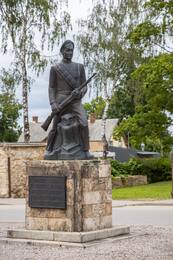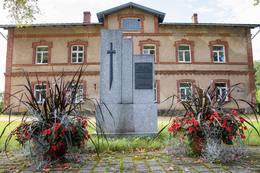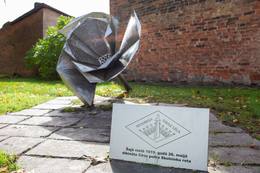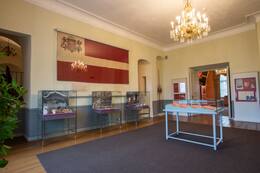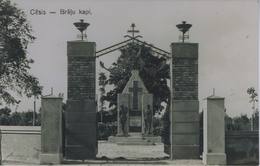Cēsis Regiment Schoolboys' Company
I Wars of Independence
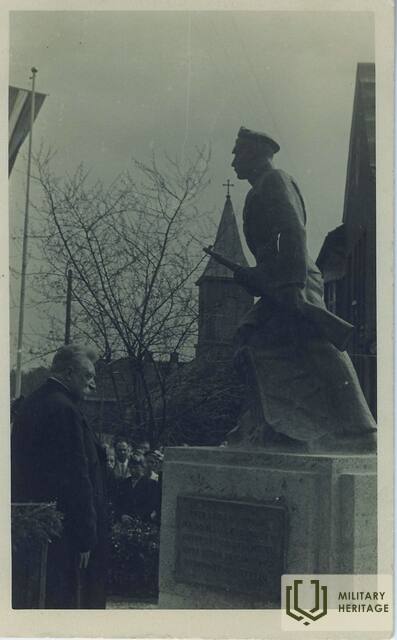
The Cēsis Regiment's School Company was a military unit formed from young people from Valmiera and Cēsis schools on the eve of the Battle of Cēsis in May and June 1919. The company participated in the Cēsis and all subsequent battles of the regiment.
On May 26, 1919, when Estonian troops liberated Valmiera from the Bolsheviks, under the leadership of the local secondary school gym teacher Alfrēdis Lukstiņš (later company sergeant), the registration of volunteer students began for the creation of a self-defense group based on the model of the Estonian army student company. About 70 young people applied in Valmiera, who were ready to join the units of the 2nd Cēsis Regiment, which went from Rūjiena through Valmiera to the Latgale front. About 40 Cēsis students had also begun to form a volunteer senior school unit based on the Valmiera students' model. The initiative of the Valmiera and Cēsis students was actively supported by the directors of the Valmiera and Cēsis secondary schools, Ludvigs Adamovičs and Longins Ausējs.
The unification of the youth of Valmiera and Cēsis took place on June 5 in the premises of the former Cēsis German Progymnasium on Dārza Street. The students, a total of 108 people, were enrolled in the 8th Company of the 2nd Cēsis Infantry Regiment (the company continued to be called the Pupils' Company), and Senior Lieutenant Gustavs Grīns was appointed as the company commander. It was planned that military training would begin the next day, but already on the first night (from June 5 to 6), some soldiers of the company were ordered to the Estonian army armored train as local acquaintances. The others also received rifles and after a few hours the order was given to go to the front in the Mācītājmuiža - Meijermuiža district, because the Germans had begun an attack. After fierce battles, units of Estonian and Latvian troops were nevertheless forced to leave Cēsis and retreat in the direction of Liepa (Lode) and Rauna.
In the first battle, several schoolchildren were wounded, but Edgars Krieviņš from Valmiera died on the same day from a very serious wound in the stomach. During the War of Independence, the company lost 9 fallen and dead. Edgars Krieviņš was posthumously awarded the Lāčplēsis War Order. The company's first sergeant-major, Alfreds Lukstiņš, was also awarded the LKO.
In 1929, as the 10th anniversary of the Battle of Cēsis and the company approached, the Society of Retired Soldiers of the Former Cēsis Regiment Volunteer Student Company was founded, which actively engaged in the patriotic education of youth. An important tradition of the society is associated with the flag of the Cēsis Regiment Student Company. Funds for the production of the flag were donated by students and teachers from nine gymnasiums in Northern Latvia, whose students joined the company in 1919. The design of the flag was drawn by the former company soldier, architect Kārlis Dzirkalis. The flag was made by seven students of the Cēsis State Gymnasium under the guidance of needlework teacher Anna Brinceva. On June 22, 1929, in Cēsis, on Heroes' Remembrance Day, a solemn service was held to consecrate the flag of the Cēsis Regiment's volunteer student company, after which the President of Latvia Gustavs Zemgals presented the flag to the organizer of the company, LKO cavalier A. Lukstiņš. For the first year, the flag was kept in Cēsis, but in 1930, a tradition was started - the transfer of the flag of the former Cēsis Regiment's Student Company for storage for a year to one of the gymnasiums of North Vidzeme. From then on, with the consent of the Ministry of Education, the flag was kept: in 1930 - in Valmiera, in 1931 - in Limbaži, in 1932 - in Mazsalaca, in 1933 - in Rūjiena, in 1934 - in Valka, in 1935 - in Alūksne, in 1936 - in – in Gaujiena, 1937. – in Smiltene, 1938. – again in Cēsis and 1939. – in Valmiera. In 1940, the flag was last transferred to the Limbaži Gymnasium for safekeeping. With the opening of the renovated Victory Monument in Cēsis in 1998, the tradition of the traveling flag of the Cēsis Regiment's Student Company was re-established.
More information sources
The sun rose from the sword: a collection of memories and documents about the Cēsis Regiment's Student Regiment in 1919. Memories and documents arranged for publication by Tālis Pumpuriņš. - Cēsis, Cēsis Museum Association, 1994. - p. 120.
Juris Ciganovs. Schoolchildren's company in the battles of 1919. SARGS.LV 31.05.2011. https://www.sargs.lv/lv/latvijas-neatkaribas-kars/2011-05-31/skolnieku-rota-1919-gada-kaujas
Related timeline
Related objects
Monument for students of the Cēsis Regiment
The monument to the soldiers of the Cēsis Regiment Students’ Company who died in the Battles of Cēsis is located in the city of Cēsis, near the intersection of Palasta and Bērzaines streets. The construction of the monument was proposed by the Soldiers’ Association of the Cēsis Regiment Students’ Company. The monument was unveiled on 26 May 1938. The monument is based on the idea sketched by artist Jānis Rozenbergs, a former soldier of the company. Placed on a metre-high limestone pedestal, the 1.8-metre copper sculpture of a soldier dressed in a school student’s uniform was created by sculptor Rūdolfs Āboltiņš and coppersmith Jānis Zibens. An owl, a symbol of wisdom and knowledge, lies at the soldier’s feet, squatting on and protecting the books of a student who went to war. The sculpture was demolished during the Soviet re-occupation in 1952. A monument named the Komsomol Flag Bearer by sculptor Kārlis Jansons was erected near its former location in 1957. Placed near its historic site, the restored monument was unveiled on 11 November 1992. At the same time, in 1992, a monument to the Komsomol, which had been erected by the occupation regime, was taken down.
Monument at the site of the Battle of the Schoolchildren's Company
On the side of the Cēsis-Āraiši highway, near the former Livu parish house.
A monument dedicated to the volunteer student company of the Cēsis Regiment, which participated in the Battle of Cēsis in 1919, can be seen.
The monument was unveiled on May 29, 1930, near the former Livu parish house.
The monument project was developed by former student volunteer K. Dzirkalis, and the installation work was carried out by A. Sproģis' company in Cēsis.
The bronze details were made by M. Pluka according to the author's drawing, and they were cast at the V. Minūtas factory in Riga. After World War II, the monument was destroyed.
Restored on June 6, 1989, the authors of the restored monument were sculptors A. Jansons and M. Baltiņa, and architect I. Timermanis.
Later, the bronze sword and plaque were removed for safety reasons, replaced with wooden parts.
Monument to the first fallen soldier of the School Company, Edgars Krieviņš
Located in the Valmiera City Center Cemetery, near the chapel (Miera Street 1/3, Valmiera)
A soldier of the 8th (Student) Company of the Cēsis Regiment, LKOK Edgars Krieviņš (1899-1919), died on June 7 from injuries sustained in the Battle of Cēsis on June 6, 1919, when, when the enemy attacked, he covered the retreat of the rest of the units.
Memorial sign at the site of the founding of the Cēsis Regiment's Student Company
Located at Leona Paegles Street 1, near the facade of a red brick building.
The author of the memorial is artist Solveiga Vasiļjeva, and the idea is based on the motif of a flower bud. As the artist points out, it symbolizes personalities that have just begun to form – students who must make an important, responsible and tough decision in their still short lives.
In the form of the memorial, the outer petals of the flower bud are designed geometric, with sharp corners, in contrast with the soft, rounded ones inside the bud. The height of the memorial is up to 1.5m. The memorial was unveiled on May 26, 2011 in Valmiera, at the place where the Cēsis Regiment cadet company was formed in 1919.
The outlines of Latvia are laid out from artificial paving stones, on which a plaque with the flag of the Cēsis Regiment's Pupils' Company and the text is placed lying down:
"In this place on May 26, 1919
"Cēsis Regiment School Company" was founded
Cēsis history and art museum in the New Castle of Cēsis
The Cēsis History and Art Museum is located in the very centre of the Old Town of Cēsis, in the New Castle. The museum holds a permanent exhibit of history and interiors named ‘Cēsis, a Symbol of Latvian History’, with two thematic sections: the exhibit ‘Red-White-Red Flag in the History of Cēsis and Latvia’ explains the history of the Latvian national flag from the 13th to 20th centuries, the approved national symbol, the flags of Latvian rifle battalions and the traditions of using national colours during the Latvian War of Independence. The exhibit ‘Cēsis and the Latvian War of Independence’ focuses on the founding of the Cēsis Company in December 1918, the joint battle efforts of Estonians and Latvians in the 1919 Battles of Cēsis, the time when, during the Bermondt Affair, Cēsis served as the temporary capital of Latvia for a short time, as well as the history of the Cēsis Victory Monument. In an escape room named ‘Legends of the Battles of Cēsis’, the participants have one hour to find their way out by solving puzzles, making connections and finding hidden objects. The Cēsis Company, one of the first units of the Latvian Armed Forces, was established on 8 December 1918 in Cēsis Castle by Senior Lieutenant Artūrs Jansons. The museum’s exhibit features a memorial plaque dedicated to the Cēsis Company, unveiled on 8 December 1933 at the Cēsis New Castle, which, at the time, served as the headquarters of the 8th Daugavpils Infantry Regiment and the garrison officers’ club.
Cēsis Brothers' Cemetery
Located in the Cēsis Lower Cemetery, Lenču Street 15, Cēsis.
One of the most significant memorial sites of the First World War and the War of Independence in Cēsis is the Brothers' Cemetery in Lejas Kapis.
The cemetery houses the Brothers' Cemetery Monument, designed by Cēsis artist and councilor Augusts Julla (1872-1958), unveiled in 1927, and dedicated to the soldiers buried in the Brothers' Cemetery from 1915 to 1920.
About 200 soldiers are buried in the Brothers' Graves of the Cēsis Leja Cemetery. Among them are an unknown number of Latvian riflemen and Russian soldiers who fell in World War I, as well as soldiers of German (10), Polish and other nationalities. During the Latvian Liberation Struggles, 22 soldiers of the 5th (2nd) Cēsis Infantry Regiment were buried in this cemetery, as well as 11 freedom fighters who fell in other Latvian army units. 2 Estonians, 15 victims of the Bolsheviks, and Latvian Red Riflemen also rest in the Brothers' Graves.
Railway bridge over Amata
Located in Drabeši parish, Cēsis region, near the recreation area "Meža koujas".
A railway bridge over the Amata River is visible.
The railway bridge over the Amata River plays a very important role throughout the course of the War of Independence, as the first battle between the Estonian army's armored trains and the Baltic Landeswehr units took place here on June 5, 1919. The Landeswehr, knowing that the armored train was approaching, mined the railway bridge and took up positions in the "Amata" houses on the riverbank, ready for possible hostilities. The bridge over the Amata River was the border between the Estonian forces and the Germans.
Historical evidence of the events at the Amata Bridge has not been preserved. Since Latvians did not participate in these events, there are no memoirs from them, there are memories from Estonian soldiers, other sources. It can be said that this was a joint Estonian-American battle against the Landeswehr, because an American officer was on the Estonian armored train, who later also fought in World War II. In general, many future officers and commanders of World War II participated in the Cēsis battles, especially on the German side.
The Estonian armored train arrived in Cēsis on June 2, 1919, and a day later went to Ieriķi, where negotiations with the Landeswehr took place, which were fruitless, and on June 5, when the armored train again approached the Amata Bridge, a clash with the Germans began. The armored train also took part in the battles near Cēsis a day later, where it helped the soldiers of the Schoolchildren's Company, who were threatened with encirclement. Although the Germans tried to dismantle the tracks to cut off the train's retreat, it managed to retreat across the Rauna Bridge.
On the night of June 23, 1919, during the Battle of Cēsis, the Landeswehr abandoned Cēsis and retreated to the Amata River. While retreating, the Germans burned down the Cēsis Latvian Society building and blew up the bridge over the Amata.
Related stories
The unusual story of the monument to the Cēsis Regiment's School Company
The Cēsis Regiment volunteer schoolboy company participated in the 1919 Cēsis battles, which formed as a combat unit from 108 young people from Valmiera and Cēsis schools on June 5 in the former Cēsis German Progymnasium premises on Dārza Street (now Bērzaines Street 4). Already on the night of June 5 to 6, about an hour after midnight, there was an alarm and the company was ordered to go to positions. The company went out to the Mācītājmuiža – Meijermuiža line, which was considered the most important battle area.
The monument dedicated to the Cēsis Regiment student detachment near the former Livu Parish Hall
The Cēsis Regiment volunteer schoolboy company participated in the 1919 Cēsis battles, which formed as a combat unit from 108 young people from Valmiera and Cēsis schools on June 5 in the premises of the Cēsis Progymnasium. Already on the night of June 5 to 6, about an hour after midnight, there was an alarm and the company was ordered to move to positions. The company moved to the Mācītājmuiža - Meijermuiža line, which was considered the most important battle area.
In the first battle, several schoolchildren were wounded, but Edgars Krieviņš, a Valmiera native, died on the same day from a very serious wound to the stomach. He was buried with military honors at the Valmiera City Cemetery on June 13. Edgars Krieviņš was posthumously awarded the Lāčplēsis War Order.
The beginning, course and conclusion of the Battle of Cēsis
The victory in the Battle of Cēsis was destined to become a turning point in the Latvian and Estonian struggle for the independence of their country. This victory put an end to the plans of the Andrievs Niedra government and the German general Rüdiger von der Goltz to conquer the Baltics. Instead, the Latvian Provisional Government of Kārlis Ulmanis resumed its activities in Liepāja.





